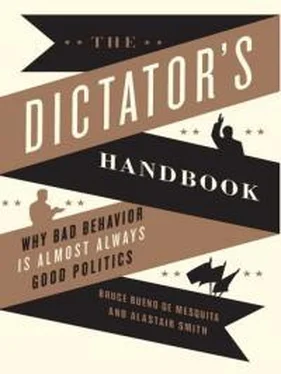Carly Fiorina became Hewlett-Packard’s CEO in 1999. After six turbulent years she was deposed from that position and as chairwoman of the board in early 2005. Prior to being removed she was the target of an unsuccessful proxy fight mounted by Walter Hewlett and David Woodley Packard, sons of HP’s founders. The board, in keeping with the power of inherited insider influence, also included Susan Orr, founder David Packard’s daughter. All were individuals with big financial stakes in HP. Furthermore, as big shareholders Hewlett, Packard, and Orr were more concerned about HP’s overall performance than about any private benefits they got from being on the board. Good news for shareholders—potentially bad news for Fiorina.
The board that selected Fiorina as CEO consisted of fourteen members. As we’ve seen, three were relatives of HP’s founders; three more were current or retired HP employees.3 Fiorina’s initial board, in other words, had a substantial group of insider and grey members who were not of her choosing and who had big stakes in the corporation’s stock value. It is not hard to see that Carly Fiorina needed to make changes to build a leaner board with stronger attachments to her. It would not be easy—while the previous board selected her, they were not her handpicked loyalists.
She achieved results, nonetheless. A year after Fiorina’s ascension, HP’s proxy statement to its shareholders in 2000 listed only eleven board members, 20 percent fewer than the group that selected her. Three, including David Woodley Packard, were gone. As Fiorina became more entrenched in her position, the board continued to shrink—the 2001 statement listed only ten board members, a reduction of nearly 30 percent from the board she originally inherited. Seemingly growing more secure in her control, Fiorina launched an effort to merge Compaq with HP, an effort with both beneficial prospects and serious risks for her continued rule.
Naturally, Fiorina presented the merger as a boon for HP and its shareholders. As Fiorina explained on February 4, 2002,
It is a rare opportunity when a technology company can advance its market position substantially and reduce its cost structure substantially at the same time. And this is possible because Compaq and HP are in the same businesses, pursuing the same strategies, in the same markets, with complementary capabilities. So, yes, we thought about a go-slow approach. But, we concluded, after two-and-a-half years of careful deliberation and preparation, that standing still had enormous risks.... Standing still means choosing the path of retreat, not leadership.4
There is no reason to doubt the sincerity of Fiorina’s expectations for the Compaq merger. But it is instructive to examine a major indicator of how Fiorina’s appointment and how her views meshed with broader market sentiments. The day before the announcement of Carly Fiorina’s appointment as HP’s new CEO, HP’s shares traded at $53.43. The market’s reaction to her appointment can reasonably be described as uncertain. The price of HP shares was flat immediately following the announcement and then began a decline, falling to under $39 by mid-October 1999, about three months later. Of course, markets are forward looking and so investors were watching and learning, modifying their expectations as Fiorina took charge. The news and modified expectations must have been good for a while because by early April 2000, HP’s shares had risen markedly to about $78. But good feelings and good circumstances were not to prevail for long. After April 7 the share price went into a tailspin, bottoming out in September 2002 at around $12 a share, and significantly underperforming the major stock market indexes. By the time Fiorina resigned in February 2005, HP’s share price had only rebounded to about $20.
With respect to the Compaq merger, the market was similarly pessimistic. The plan to merge with Compaq was announced on September 3, 2001. The shares rose on the news, with a peak in December of that year of about $23, though still well below the value the day before Carly Fiorina became CEO. Over the period from July 1999 (the announcement of Fiorina’s appointment) to the end of December 2001, the adjusted Dow Jones index fell 9.4 percent while HP’s adjusted share price fell 47 percent.
From the perspective of any big investor in HP, including the Hewlett and Packard families, Fiorina must have looked like a disaster. Their company was doing worse than the general stock market; their fortunes were being hammered. She was a CEO in trouble. Nevertheless, the upward tick in the share value indicated a renewed, if temporary, boost of optimism at the announced intention to merge with Compaq. But markets don’t like infighting, and when Walter Hewlett and David Woodley Packard declared their opposition to the merger, the gains were reversed. Soon the price collapsed even further, halving as it became apparent that there was to be a proxy fight in which Hewlett and Packard sought to muster support from enough shareholders to defeat the board’s proposed slate at the corporation’s annual meeting. No doubt Fiorina realized that she was going to be in for a tough time, perhaps even before her public announcement of the intended and eventually successfully completed merger. It also seems likely that she would already have known Hewlett and Packard’s views. We can only conclude that this was an intentional gamble on a major policy shift, one that could—and did—adversely affect the wealth of HP’s large shareholders (such as present or former board members Hewlett and Packard).
Looking at the Compaq-HP merger politically, we can see several critical themes emerging. Fiorina was already in some trouble because of declining share value. She had successfully diminished the board’s size and shuffled its membership, both wise choices for a CEO seeking longevity in office. Yet despite these actions, she still faced significant opposition from the inner circle of essentials and influentials. She had not yet secured the board’s loyalty. The Compaq merger might have made good business sense and could therefore have been good for the stock price, thus softening internal opposition to her. Or else, seeing the merger as a fait accompli, her opponents might have given up their fight. That didn’t happen. And the disgruntled board members, heavily invested as they were in HP’s stock value, could not be mollified with private rewards.
However, what in retrospect may seem like a political nonstarter at the time held great political advantages. What, for instance, had to be an implication for board composition of Fiorina’s multibillion dollar merger with Compaq? Once the deal was sealed Fiorina would have to bring some Compaq leaders onto the postmerger HP board. This could be done either by expanding the existing board to accommodate Compaq influentials or by pruning the existing board to make room for the new, Compaq representatives drawn from Compaq’s selectorate. Fiorina apparently saw that the merger would provide an opportunity to reconstitute the board, providing an undeniable opportunity to weaken the board faction that opposed her. That seems to be exactly what she tried to do.
Of course, her rivals would not sit idly by and be purged. Unless such a purge can be accomplished in the dark, presented as a fait accompli to the old group of influentials, the risk of failure is real. As it happens, Securities and Exchange Commission (SEC) regulations require disclosures, which make turning a board purge into a fait accompli extremely difficult when the opportunity to purge the board depends on a prospective merger.
There are two potential responses to a rebellion such as the one Fiorina faced over HP’s weak share price and the Compaq merger. A CEO can either purge essentials and boost the private benefits to remaining coalition members, or expand the coalition and increase rewards to the general selectorate of interchangeables (that is, shareholders). Having survived the proxy fight in 2002, Fiorina faced an eleven-member board that included five new members carried over from Compaq as part of the merger. HP’s board had shifted materially with only six previous HP board members on it. Since Fiorina had been the mover and shaker behind the Compaq deal it is reasonable to believe that she assumed the new members would be likely to work with her as opposed to lining up with board members who had supported Walter Hewlett’s fight against the merger. Walter Hewlett and Robert P. Wayman, meanwhile, left the board. By this time Fiorina had expanded the total board size by only one, from ten to eleven, while overseeing the departure of several old board members at the same time to make room for five Compaq representatives. Surely she had reason to believe she now enjoyed the support of a majority of the new board.
Читать дальше












